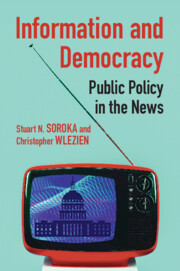Book contents
- Information and Democracy
- Communication, Society and Politics
- Information and Democracy
- Copyright page
- Contents
- Figures
- Tables
- Preface
- 1 Media in Representative Democracy
- 2 Public Responsiveness to Media
- 3 Measuring the “Media Signal”
- 4 Alternative Measures of the Media Policy Signal
- 5 The Accuracy of Media Coverage
- 6 Policy, the Media, and the Public
- 7 Diagnosing and Exploring Dynamics
- 8 Policy and the Media
- References
- Index
- Other Books in the Series (continued from page iii)
3 - Measuring the “Media Signal”
Published online by Cambridge University Press: 20 January 2022
- Information and Democracy
- Communication, Society and Politics
- Information and Democracy
- Copyright page
- Contents
- Figures
- Tables
- Preface
- 1 Media in Representative Democracy
- 2 Public Responsiveness to Media
- 3 Measuring the “Media Signal”
- 4 Alternative Measures of the Media Policy Signal
- 5 The Accuracy of Media Coverage
- 6 Policy, the Media, and the Public
- 7 Diagnosing and Exploring Dynamics
- 8 Policy and the Media
- References
- Index
- Other Books in the Series (continued from page iii)
Summary
This chapter moves from theory to practice and implements a measure of media coverage. We introduce our database of news coverage. We also described the unique “layered dictionary” approach used to identify sentences on the direction of policy change. The focus on change in policy and not levels is critical, and we discuss this in some detail. We also compare the use of application of both dictionary and supervised machine-learning approaches to content analyses of news content. This chapter is necessarily technical, but it also is an opportunity for us to introduce the methods to a broader audience. We plan to escort readers through the various available approaches, our implementation of them, and then an assessment of the outputs they produce. We end the chapter with some substantive findings: the overall amount of coverage of policy change in newspapers and television, and the general trends in aggregated “media signals” generated by the different approaches.
Keywords
- Type
- Chapter
- Information
- Information and DemocracyPublic Policy in the News, pp. 39 - 61Publisher: Cambridge University PressPrint publication year: 2022

